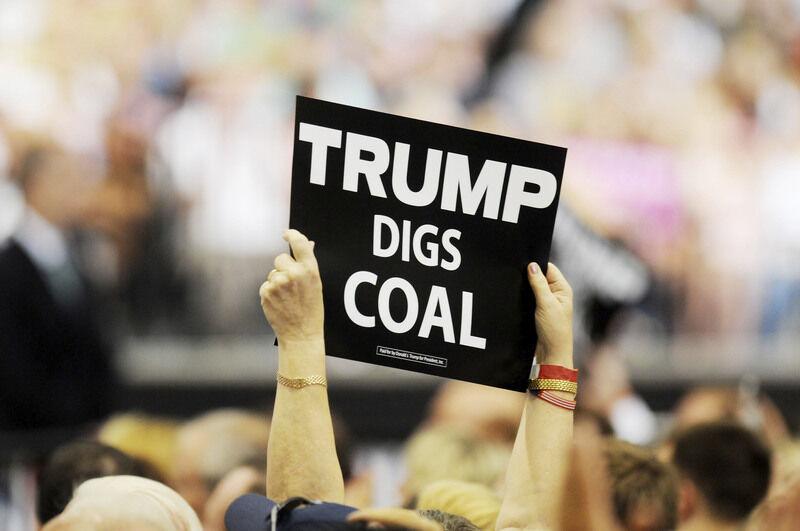Despite Efforts, Trump Fails to Turn Coal Fortunes

By Ari Natter and Will Wade
September 13, 2020 - President Donald Trump spent more than $1 billion in taxpayer funds, rolled back environmental rules and tried to stop power plant closings to fulfill a vow he made to West Virginia coal miners in the 2016 campaign.
But nothing he’s done is rescuing the coal industry.
Since Trump’s inauguration, U.S. coal production – after a slight uptick in 2017 – is expected to be down 31 percent this year from 2016 levels. By some estimates, more than five dozen coal-burning power plants have closed and although mining jobs remained steady before dropping this year, they didn’t increase.
“They’ve tried to do a lot but very little has been effective,” said Seth Feaster, an analyst with the Institute for Energy Economics and Financial Analysis, an organization that focuses on transitioning to a diverse, sustainable and profitable energy economy. “It’s a pretty bleak picture for coal.”

A Trump supporter holds a sign “Trump Digs Coal” during President Donald Trump’s campaign rally at Big Sandy Superstore Arena in Huntington in 2017.
Photo: Chris Jackson, The Register-Herald
Trump honed his appeal to working class Americans by donning a hard hat and promising to get miners back to work four years ago, but now Democrat Joe Biden is courting the same blue-collar voters.
There is little Trump has been able to do as utilities continue to shun coal in favor of dirt cheap natural gas and increasingly renewables. Coal, which once accounted for more than half of all U.S. electricity generation, is expected to account for just 18 percent of the U.S. power mix this year, according to the U.S. Energy Information Administration.
Coal was surpassed by gas as the top source of U.S. electricity in 2016. This year, the dirtiest of all fossil fuels will be exceeded in the power supply for the first time by renewables.
U.S. coal production has been declining steadily since it peaked in 2008. While there was a slight uptick in 2017, Trump’s first year in office, it’s expected to be about 502 million tons this year, down 31 percent from 2016. Exports, which have helped support U.S. miners, are also shrinking amid increasing competition from liquefied national gas in Asia and waning demand in Europe. U.S. producers will export about 60 million tons this year, down 48 percent from 2018.
Covid-19, which has sapped U.S. power demand, has only hurt the industry further, and the export market, once seen as a savior for the industry, has evaporated as well, said Mark Levin an analyst with the research firm, The Benchmark Co.
“Retirements of coal plants will continue, and I don’t think Trump has had any meaningful impact,” Levin said. “Consumption this year has completely fallen off a cliff.”
Since Trump’s inauguration, 65 coal-fired power plants have been retired, and 72 more plants have announced plans to do so, according to the Sierra Club.
Trump administration officials are defending its efforts to help the industry. The U.S. has 450 years worth of coal reserves and it’s working on developing clean-burning coal plants and carbon-capture technology that can be exported around the world to other coal burning nations, they say.
“This administration doesn’t believe it’s a four-letter word,” Steven Winberg, the Energy Department’s assistant secretary for fossil energy, said in an interview.
The Energy Department has spent more than $1 billion on coal, including on the development of small-scale coal plants that officials say could be fired up more quickly than bigger ones to allow it to meet power fluctuations on an electric grid that is increasingly dependent on renewable energy.
The agency is also researching alternative business uses for coal, including extracting rare earth elements, such as those needed for use in mobile phones, batteries and medical supplies. Another idea is to turn the rocks into building materials, such as roof tiles or decking.
Coal industry supporters say some of the Trump administration’s moves to roll back Obama-era regulations on power plant pollution and to keep mining waste out of streams and ground water have helped the industry – at least in the margins.
“It’s going to be around for a long time,” Winberg said. “Take all the coal out of the United States and it really doesn’t move the needle in terms of overall emissions.”
In the meantime, utilities are shunning coal as they turn to wind, solar and battery storage for power.
Ohio-based American Electric Power Co. has retired 8,382 megawatts of coal power since 2011 and announced plans to invest heavily in solar, wind and natural gas.
Mining jobs, which remained relatively steady for Trump’s first three years in office, dropped after the coronavirus outbreak by about 18,000 to 64,000 in the second quarter of this year, according to the Mine Safety and Health Administration.

